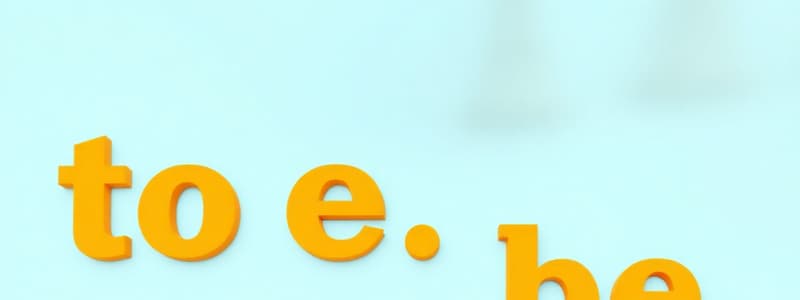Podcast
Questions and Answers
¿Qué invento facilitó la creación de mercados globales?
¿Qué invento facilitó la creación de mercados globales?
- Luz eléctrica
- Telégrafo (correct)
- Impresora de tipos móviles
- Máquina de vapor
¿Quién inventó el telégrafo eléctrico?
¿Quién inventó el telégrafo eléctrico?
- Samuel Morse (correct)
- Nikolaus Otto
- Thomas Edison
- Alexander Graham Bell
¿Qué transformó la noche en día?
¿Qué transformó la noche en día?
- Telégrafo
- Invención del papel
- Camino de hierro
- Alumbrado eléctrico (correct)
¿Qué hizo posible la iluminación nocturna segura?
¿Qué hizo posible la iluminación nocturna segura?
¿Qué recurso utiliza el motor de combustión interna?
¿Qué recurso utiliza el motor de combustión interna?
¿Qué invento dio inicio a la telecomunicación moderna?
¿Qué invento dio inicio a la telecomunicación moderna?
¿Qué mejoró la producción agrícola?
¿Qué mejoró la producción agrícola?
¿Qué sistema utilizaba puntos y rayas?
¿Qué sistema utilizaba puntos y rayas?
Flashcards
She is my teacher
She is my teacher
The correct form of 'to be' for the third-person singular pronoun 'she'.
I am not late today
I am not late today
The correct form of 'to be' for the first-person singular pronoun 'I'.
Are they happy?
Are they happy?
The correct form of 'to be' for the third-person plural pronoun 'they'.
He is at the library
He is at the library
Signup and view all the flashcards
We are not tired
We are not tired
Signup and view all the flashcards
Is she your best friend?
Is she your best friend?
Signup and view all the flashcards
I am a student
I am a student
Signup and view all the flashcards
They are not here
They are not here
Signup and view all the flashcards
Were you at the party?
Were you at the party?
Signup and view all the flashcards
It is a sunny day
It is a sunny day
Signup and view all the flashcards
He is not my neighbor
He is not my neighbor
Signup and view all the flashcards
Are we ready?
Are we ready?
Signup and view all the flashcards
I am excited
I am excited
Signup and view all the flashcards
They are not from this city
They are not from this city
Signup and view all the flashcards
Is it the right answer?
Is it the right answer?
Signup and view all the flashcards
You are very polite
You are very polite
Signup and view all the flashcards
She is not interested
She is not interested
Signup and view all the flashcards
Am I the winner?
Am I the winner?
Signup and view all the flashcards
The children are at school
The children are at school
Signup and view all the flashcards
We are not late
We are not late
Signup and view all the flashcards
Present Simple 'To Be'
Present Simple 'To Be'
Signup and view all the flashcards
Singular 'To Be'
Singular 'To Be'
Signup and view all the flashcards
Plural 'To Be'
Plural 'To Be'
Signup and view all the flashcards
Negative 'To Be'
Negative 'To Be'
Signup and view all the flashcards
Questions with 'To Be'
Questions with 'To Be'
Signup and view all the flashcards
Third Person Singular
Third Person Singular
Signup and view all the flashcards
First Person Singular
First Person Singular
Signup and view all the flashcards
Second Person Singular/Plural
Second Person Singular/Plural
Signup and view all the flashcards
Third Person Plural
Third Person Plural
Signup and view all the flashcards
Past Tense 'To Be'
Past Tense 'To Be'
Signup and view all the flashcards
Contractions
Contractions
Signup and view all the flashcards
'To Be' as a Helping Verb
'To Be' as a Helping Verb
Signup and view all the flashcards
"To Be" in Phrases and Clauses
"To Be" in Phrases and Clauses
Signup and view all the flashcards
Subject-Verb Agreement
Subject-Verb Agreement
Signup and view all the flashcards
'To Be' for Location
'To Be' for Location
Signup and view all the flashcards
'To Be' for Description
'To Be' for Description
Signup and view all the flashcards
'To Be' for Identity
'To Be' for Identity
Signup and view all the flashcards
'To Be' for Possession
'To Be' for Possession
Signup and view all the flashcards
¿Quién inventó el telégrafo?
¿Quién inventó el telégrafo?
Signup and view all the flashcards
El motor de combustión interna
El motor de combustión interna
Signup and view all the flashcards
Bombilla eléctrica
Bombilla eléctrica
Signup and view all the flashcards
Rocinante
Rocinante
Signup and view all the flashcards
Telégrafo y comercio
Telégrafo y comercio
Signup and view all the flashcards
¿Qué cambió la noche?
¿Qué cambió la noche?
Signup and view all the flashcards
El automóvil
El automóvil
Signup and view all the flashcards
Don Quijote y la caballería
Don Quijote y la caballería
Signup and view all the flashcards
Study Notes
Present Simple Tense of "To Be"
-
She is my teacher
-
I am not late today
-
They are happy with the results
-
He is at the library now
-
We are not tired after the trip
-
She is your best friend
-
I am a student at that university
-
They are not here today
-
The provided questions are Multiple Choice Questions (MCQs) testing the present simple tense of the verb "to be."
-
Subject-verb agreement is essential, meaning the verb form (is, am, are) changes according to the subject (I, she, they).
Studying That Suits You
Use AI to generate personalized quizzes and flashcards to suit your learning preferences.
Description
Test your knowledge of the present simple tense of the verb 'to be' with this engaging multiple choice quiz. Assess your understanding of subject-verb agreement by selecting the correct forms for different subjects. Perfect for learners of English looking to strengthen their grammar skills.




